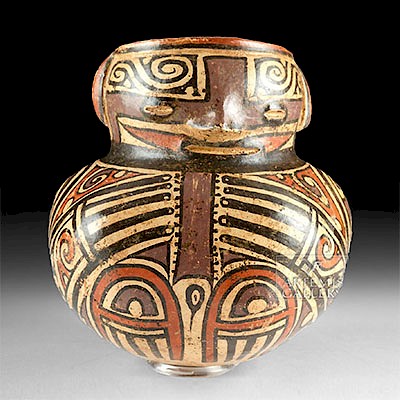Viking Silver and Bronze Charm Necklace - 56.6 g
Lot 34c
About Seller
Artemis Fine Arts
686 S Taylor Ave, Ste 106
Louisville, CO 80027
United States
Selling antiquities, ancient and ethnographic art online since 1993, Artemis Gallery specializes in Classical Antiquities (Egyptian, Greek, Roman, Near Eastern), Asian, Pre-Columbian, African / Tribal / Oceanographic art. Our extensive inventory includes pottery, stone, metal, wood, glass and textil...Read more
Estimate:
$2,500 - $3,500
Absentee vs Live bid
Two ways to bid:
- Leave a max absentee bid and the platform will bid on your behalf up to your maximum bid during the live auction.
- Bid live during the auction and your bids will be submitted real-time to the auctioneer.
Bid Increments
| Price | Bid Increment |
|---|---|
| $0 | $25 |
| $300 | $50 |
| $1,000 | $100 |
| $2,000 | $250 |
| $5,000 | $500 |
| $10,000 | $1,000 |
| $20,000 | $2,500 |
| $50,000 | $5,000 |
| $100,000 | $10,000 |
| $200,000 | $20,000 |
About Auction
By Artemis Fine Arts
Nov 8, 2018
Set Reminder
2018-11-08 10:00:00
2018-11-08 10:00:00
America/New_York
Bidsquare
Bidsquare : Ancient / Ethnographic From Around The World
https://www.bidsquare.com/auctions/artemis-gallery/ancient-ethnographic-from-around-the-world-3598
Ancient art from Egypt, Greece, Italy and the Near East, as well as Asian, Pre-Columbian, Native American, African / Tribal / Oceanic, Spanish Colonial, Russian Icons, Fine art, much more! Artemis Fine Arts info@artemisgallery.com
Ancient art from Egypt, Greece, Italy and the Near East, as well as Asian, Pre-Columbian, Native American, African / Tribal / Oceanic, Spanish Colonial, Russian Icons, Fine art, much more! Artemis Fine Arts info@artemisgallery.com
- Lot Description
Northern Europe, Viking/Norse culture, ca. 800 to 1100 CE. A fabulous collection of silver and bronze charms on a woven chain. First, a 95% silver Thor's Hammer, a pendant hammered into the form of a simple hammer with a flat head. One side of the hammer has been stamped regularly with one of the most ubiquitous metal decorations of the Viking period, triangles, with round, granulated circles nearby. These motifs were made by applying a punch onto the object's surface shortly after it was cast. Second, a silver charm in the form of four snakes who meet at the center, their bodies forming a swastika-like pattern. Third, a bronze charm in the shape of an anthropomorphic head, probably representing Thor. All of the charms hang on a silver, tightly woven trichinopoly chain with hammered silver terminals decorated with stamped triangles and circles, with two loops of wrapped silver wire and a thicker, larger loop of bronze wire holding the charms in place. Size of largest charm (hammer): 1" H (2.5 cm); length of chain: 15.25" L (38.7 cm); 56.6 grams total weight
Small Thor's hammers were worn as religious amulets throughout the Viking era, usually made of silver and usually hung on silver chains. Some even made it to the Christian era - there is a famous example of a Thor's hammer amulet from Fossi, Iceland, that has been turned into a cross (they were also invoked this past summer to describe the power of the surprisingly mighty Icelandic football team at the Euro Cup). The chain itself, meanwhile, is a style of knitwork done with thin silver wire that seems to have originated with the Vikings. The important Viking metalworking shops correspond to their great trading ports and proto-urban centers - Birka, Helgo, Sigtuna, and Lund in Sweden, Ribe, Haithabu (Hedeby), and Fyrkat in Denmark, and Kaupang and Trondheim in Norway. Silver was the principal currency of the Viking world, which stretched from Russia to northern Canada at the height of their influence. In many places, the Vikings kept silver not as coins, but as jewelry, a wearable currency form that was not subject to the authority of a monarch or mint. One of the most common archaeological finds from the Viking period is a hoard of metal objects, often buried in the earth or deposited in bodies of water, like river beds. These are found in great quantities throughout the British Isles and the Nordic countries. What was the meaning of such hoards? Were they treasures buried for safe keeping, perhaps by people fleeing violence who did not wish to travel with heavy loads and who died or forgot before they could retrieve them? Or does their presence in rivers suggest votive deposits, gifts and offerings to spirits who lived in the water?
Provenance: private New York, New York, USA collection
All items legal to buy/sell under U.S. Statute covering cultural patrimony Code 2600, CHAPTER 14, and are guaranteed to be as described or your money back.
A Certificate of Authenticity will accompany all winning bids.
We ship worldwide and handle all shipping in-house for your convenience.
#139867Dark, matte patina over the silver surfaces, with a pale green patina on the bronze. Woven chain is fragile and has some slight bending to form, as do the terminals and rings.Condition
- Shipping Info
-
All shipping is handled in-house for your convenience. Your invoice from Artemis Gallery will include shipping calculation instructions. If in doubt, please inquire BEFORE bidding for estimated shipping costs for individual items.
-
- Buyer's Premium



 EUR
EUR CAD
CAD AUD
AUD GBP
GBP MXN
MXN HKD
HKD CNY
CNY MYR
MYR SEK
SEK SGD
SGD CHF
CHF THB
THB














